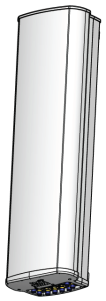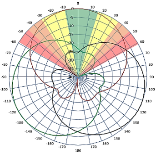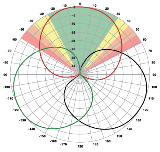|
|
|
X-Pol Octo-Port 4 ft 60° Fast Roll Off: 2 ports 698-798 MHz, 2 ports 824-894 MHz, and 4 ports 1695-2200 MHz |
|||||||||||||||||||||||||||||||||||||||||||
|---|---|---|---|---|---|---|---|---|---|---|---|---|---|---|---|---|---|---|---|---|---|---|---|---|---|---|---|---|---|---|---|---|---|---|---|---|---|---|---|---|---|---|---|
|
|
||||||||||||||||||||||||||||||||||||||||||
|
|||||||||||||||||||||||||||||||||||||||||||
| Electrical specification (minimum/maximum) | Ports 1, 2 | Ports 3, 4 | Ports 5, 6, 7, 8 | ||
|---|---|---|---|---|---|
| Frequency bands, MHz | 698-798 | 824-894 | 1695-1880 | 1850-1990 | 1920-2200 |
| Polarization | ± 45° | ± 45° | ± 45° | ||
| Average gain over all tilts, dBi | 13.0 | 13.1 | 16.6 | 16.8 | 17.2 |
| Horizontal beamwidth (HBW), degrees | 62.2 | 54.5 | 54.0 | 54.5 | 55.0 |
| Front-to-back ratio, co-polar power @180°± 30°, dB | >21 | >21 | >25.0 | >25.0 | >25.0 |
| X-Pol discrimination (CPR) at boresight, dB | >15.4 | >14 | >16 | >16 | >16 |
| Sector power ration, percent | <5.5 | <3.0 | <3.7 | <3.8 | <3.6 |
| Vertical beamwidth (VBW), degrees1 | 18.5 | 16.5 | 8.2 | 7.8 | 7.3 |
| Electrical downtilt (EDT) range, degrees | 2-16 | 2-16 | 0-9 | ||
| First upper side lobe (USLS) suppression, dB1 | ≤-15 | ≤-16 | ≤-16 | ≤-16 | ≤-16 |
| Cross-polar isolation, port-to-port, dB1 | 25 | 25 | 25 | 25 | 25 |
| Max VSWR / return loss, dB | 1.5:1 / -14.0 | 1.5:1 / -14.0 | 1.5:1 / -14.0 | ||
| Max passive intermodulation (PIM), 2x20W carrier, dBc | -153 | -153 | -153 | ||
| Max input power per any port, watts | 300 | 300 | 250 | ||
| Total composite power all ports, watts | 1500 | ||||
1 Typical value over frequency and tilt
| Mechanical specifications | |
|---|---|
| Dimensions height/width/depth, inches (mm) | 53.5/ 15.4/ 10.7 (1358.9/ 392/ 273) |
| Shipping dimensions length/width/height, inches (mm) | 60/ 20/ 15 (1524/ 508/ 381) |
| No. of RF input ports, connector type, and location | 8 x 4.3-10 female, bottom |
| RF connector torque | 96 lbf·in (10.85 N·m or 8 lbf·ft) |
| Net antenna weight, lb (kg) | 56 (25.45) |
| Shipping weight, lb (kg) | 94 (42.73) |
| Antenna mounting and downtilt kit included with antenna | 91900318 |
| Net weight of the mounting and downtilt kit, lb (kg) | 18 (8.18) |
| Range of mechanical up/down tilt | -2° to 12° |
| Rated wind survival speed, mph (km/h) | 150 (241) |
| Frontal and lateral wind loading @ 150 km/h, lbf (N) | 74.0 (329.2), 55.4 (246.4) |
| Equivalent flat plate @ 100 mph and Cd=2, sq ft | 1.48 |
| EPA frontal and lateral, ft2, (m2) | 3.3 (0.31), 3.6 (0.33) |
| Front view | Back view | Bottom view |
|---|---|---|
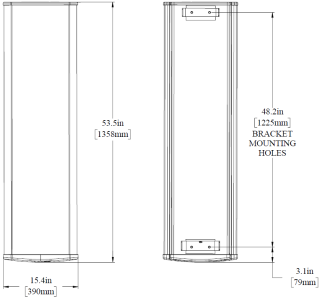
|
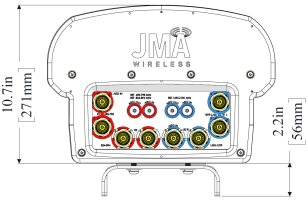
|
|
| Ordering information | |
|---|---|
| Antenna model | Description |
| MX08FRO460-02 | 4F X-Pol OCTO FRO 60°, 2-16° / 0-9° RET, 4.3-10 & SBT |
| Optional accessories | |
| AISG cables | M/F cables for AISG connections |
| PCU-1000 RET controller | Stand-alone controller for RET control and configurations |
| Remote electrical tilt (RET 1000) information | |
|---|---|
| RET location | Integrated into antenna |
| RET interface connector type | 8-pin AISG connector per IEC 60130-9 |
| RET connector torque | Min 0.5 N·m to max 1.0 N·m (hand pressure & finger tight) |
| RET interface connector quantity | 2 pairs of AISG male/female connectors |
| RET interface connector location | Bottom of the antenna |
| Total no. of internal RETs (low bands) | 2 |
| Total no. of internal RETs (high bands) | 1 |
| RET input operating voltage, vdc | 10-30 |
| RET max power consumption, idle state, W | ≤ 2.0 |
| RET max power consumption, normal operating conditions, W | ≤ 13.0 |
| RET communication protocol | AISG 2.0 / 3GPP |
| RET and RF connector topology | |
|---|---|
| Each RET device can be controlled either via the designated external AISG connector or RF port as shown below: | |
|
|
|
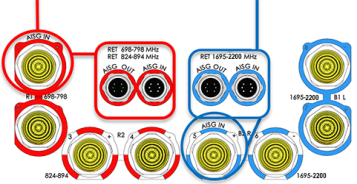
|
|
| Array topology | ||||||||||||
|---|---|---|---|---|---|---|---|---|---|---|---|---|
|
3 sets of radiating arrays R1/R2: 698-894 MHz B1: 1695-2200 MHz B2: 1695-2200 MHz |
|
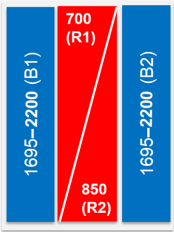
|
||||||||||
V5.0
| ©2025 JMA Wireless. All rights reserved. All products, company names, brands, and logos are trademarks™ or registered® trademarks of their respective holders. All specifications are subject to change without notice. +1 315.431.7100 customerservice@jmawireless.com |

